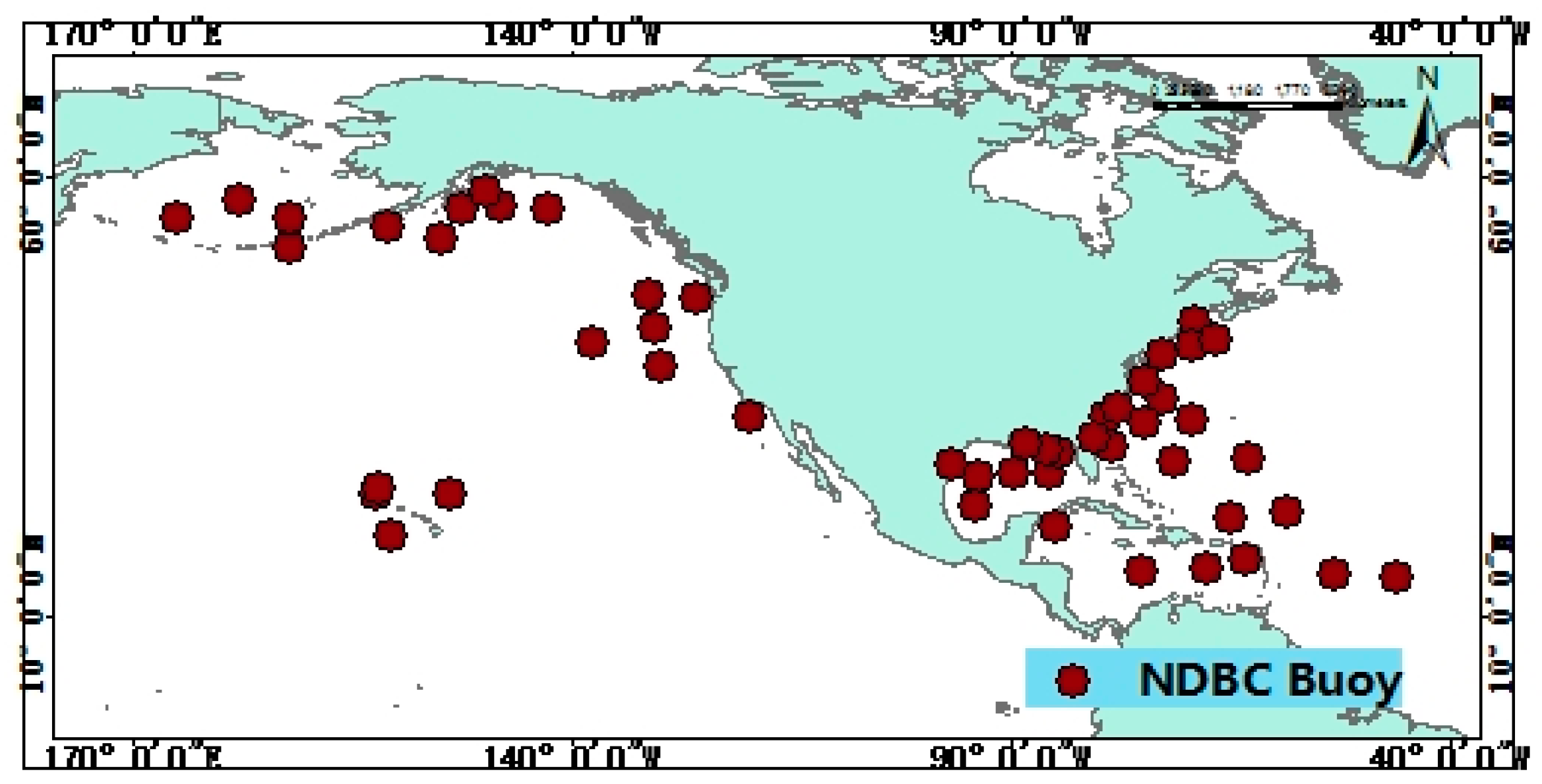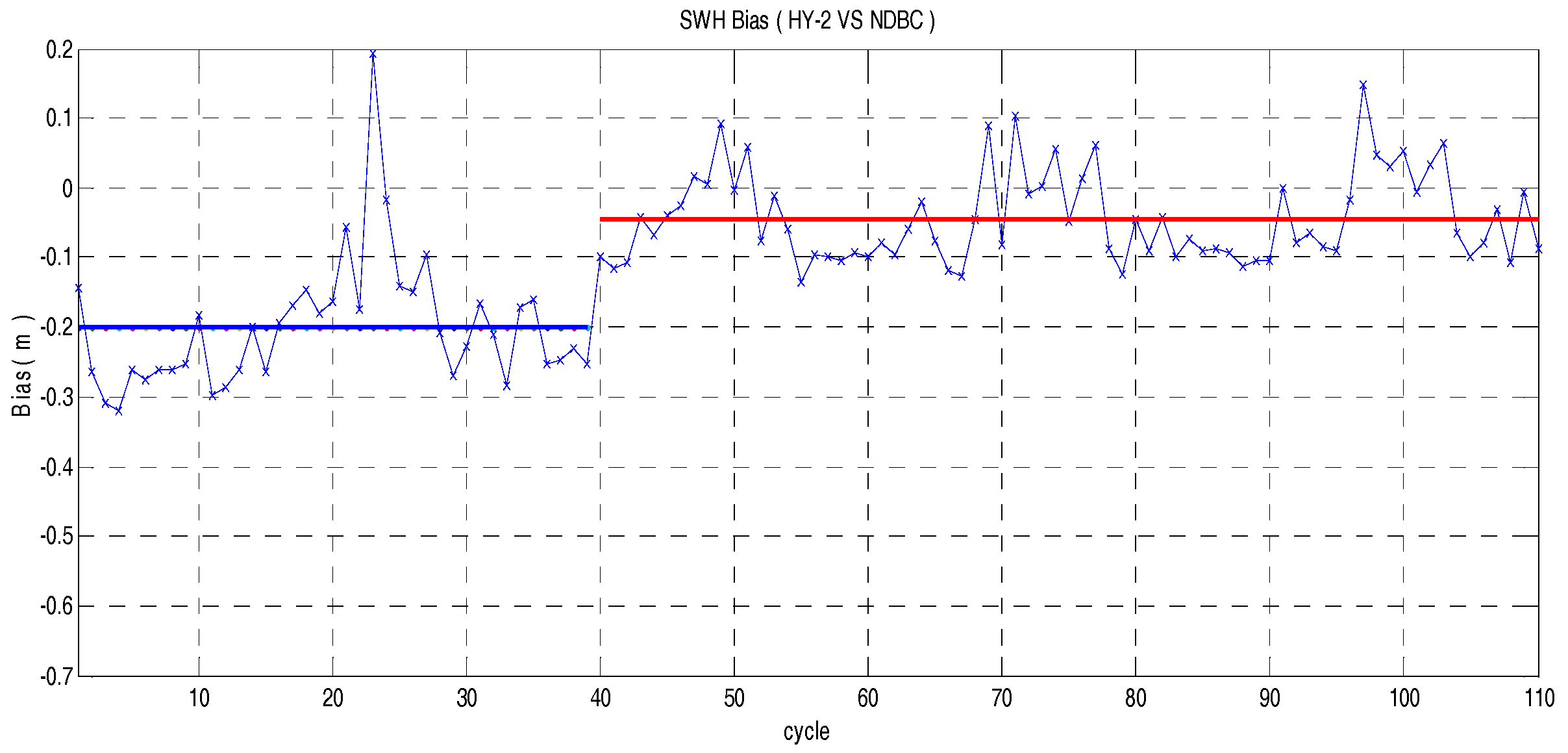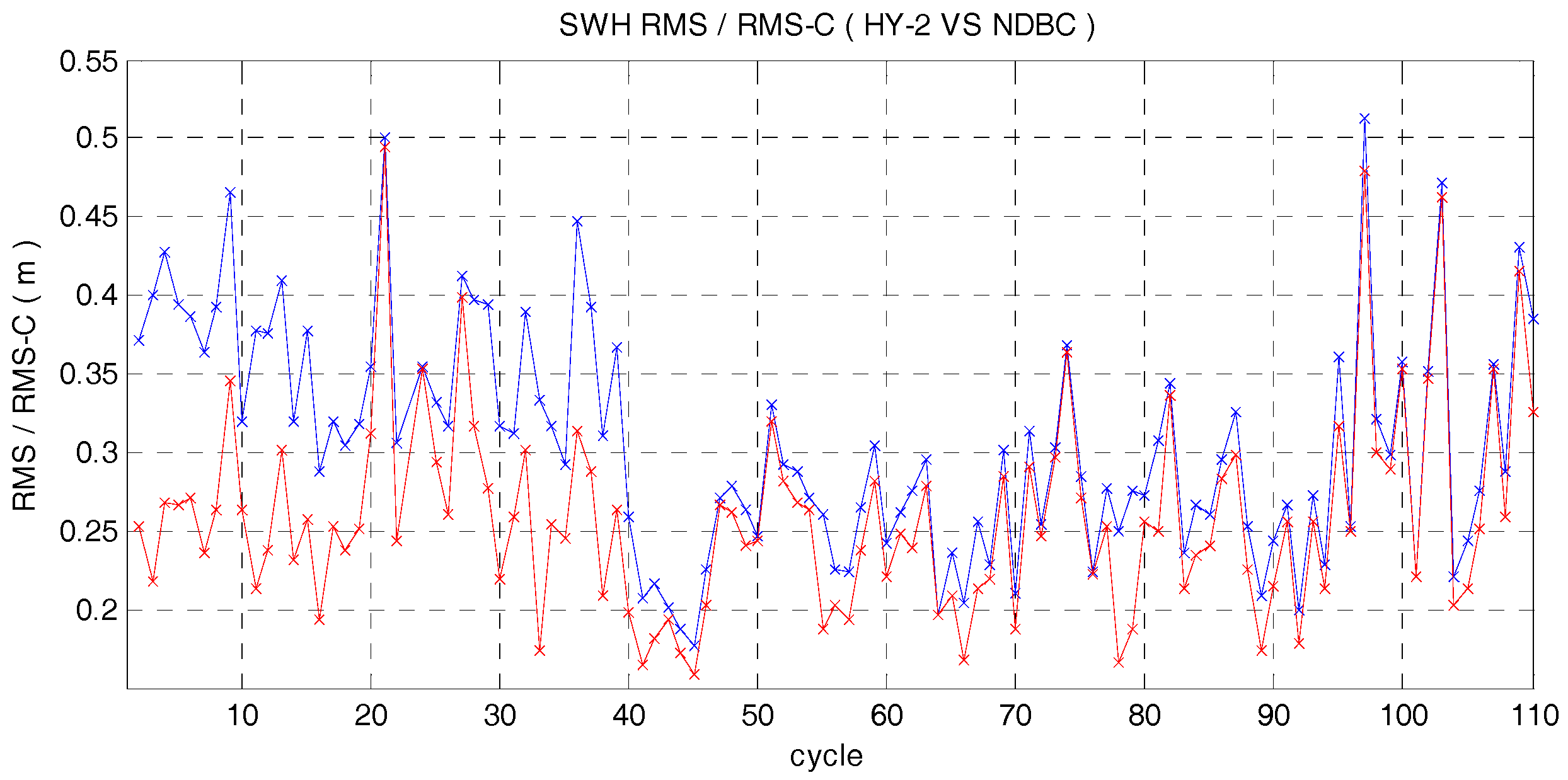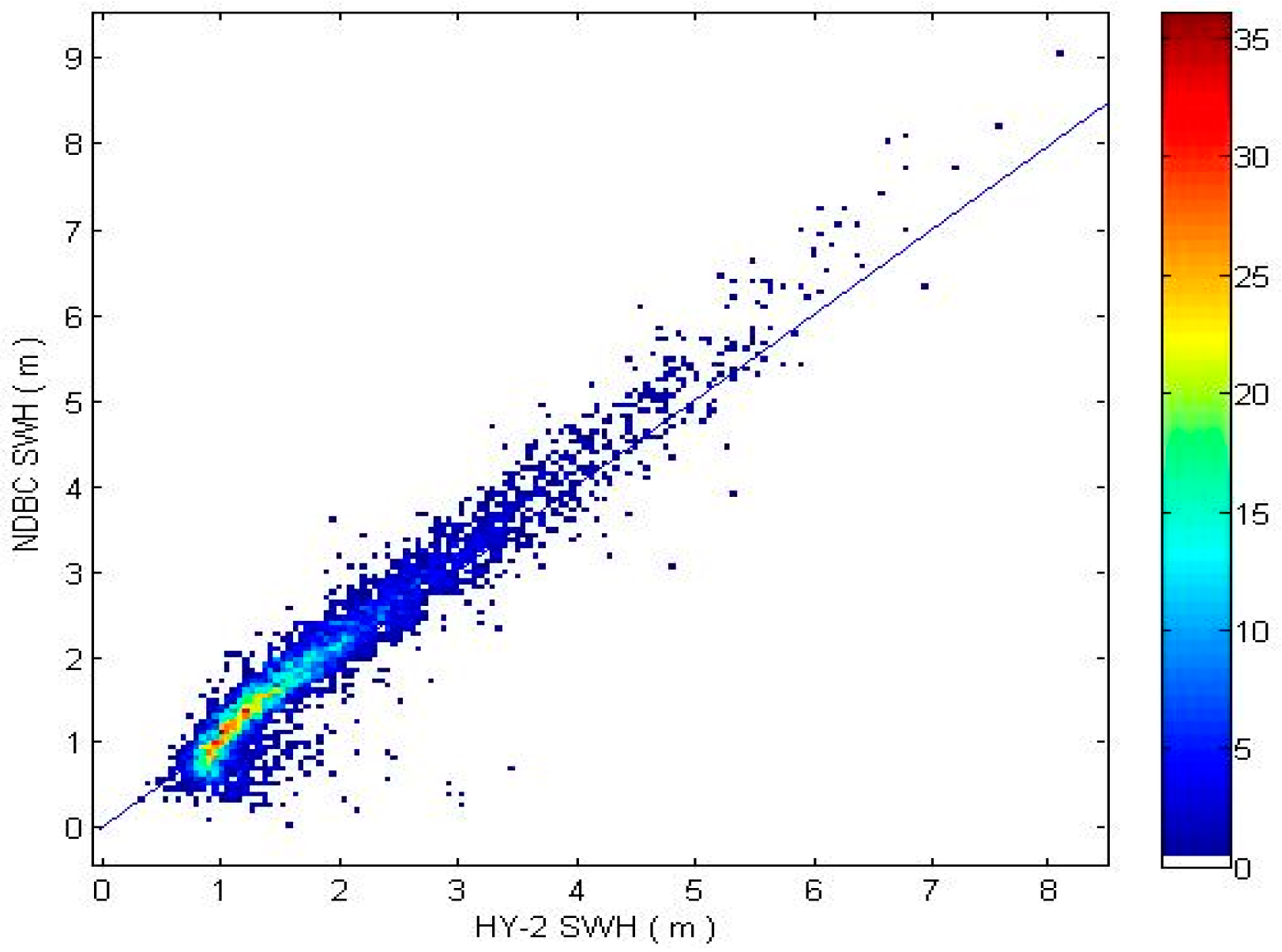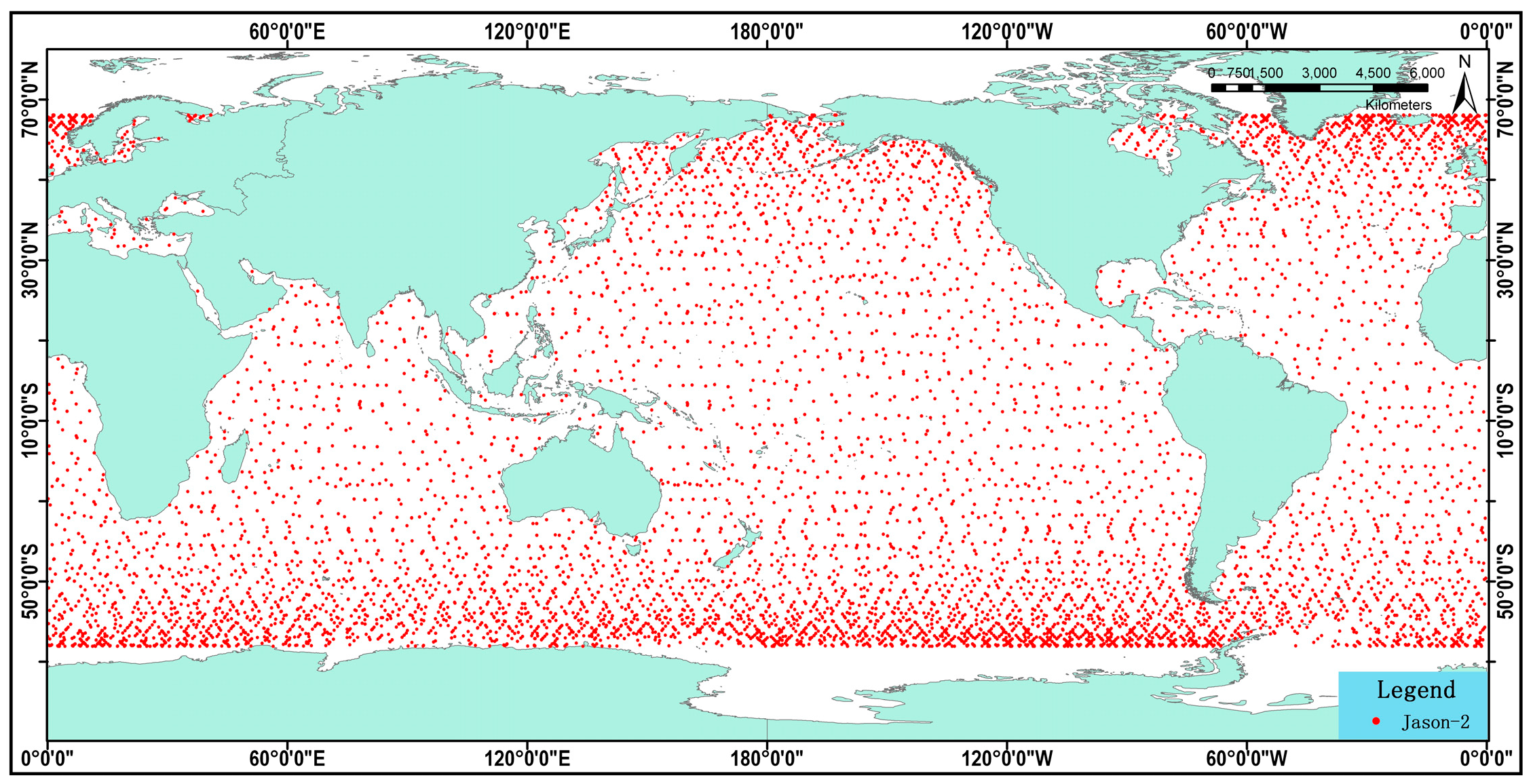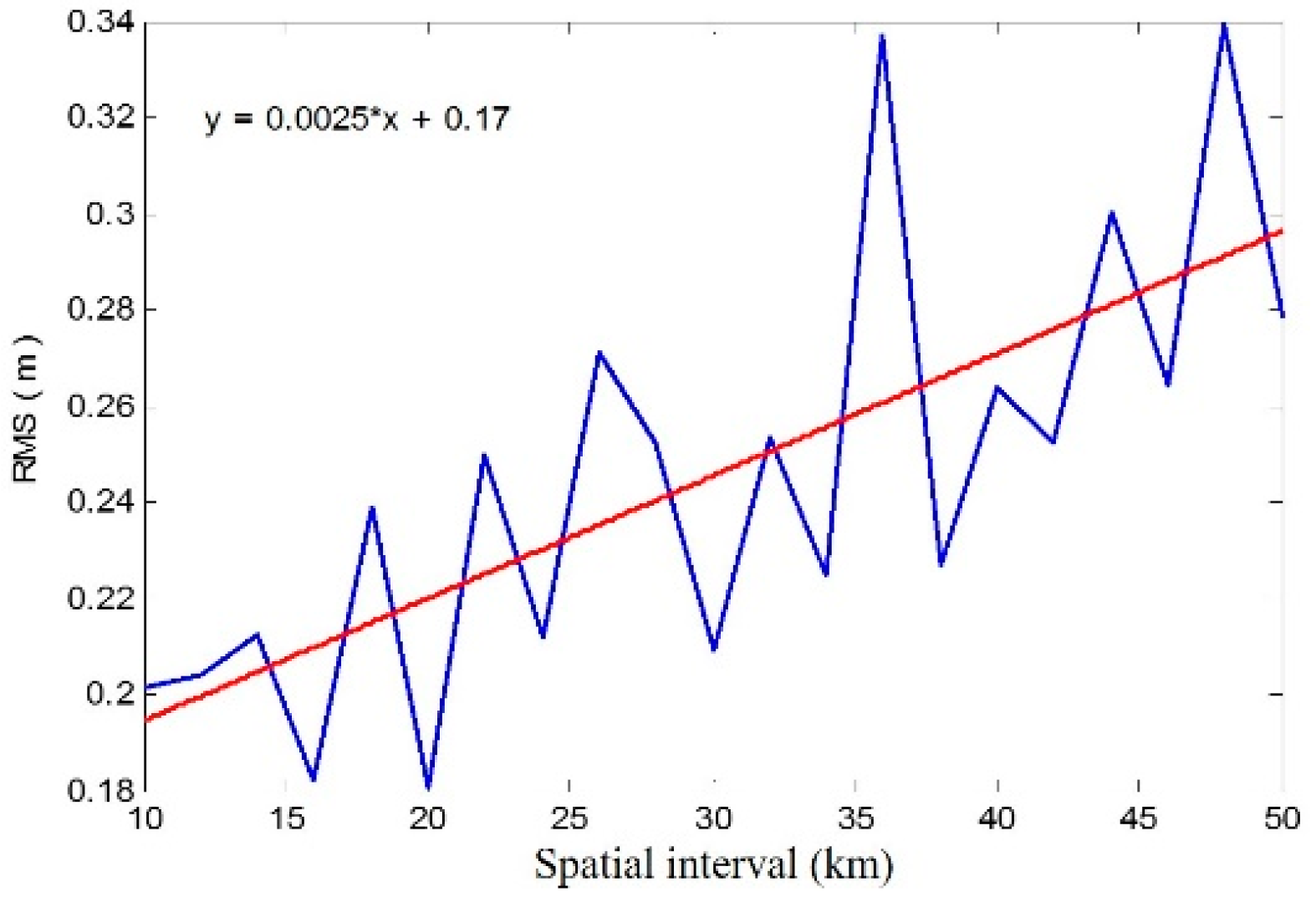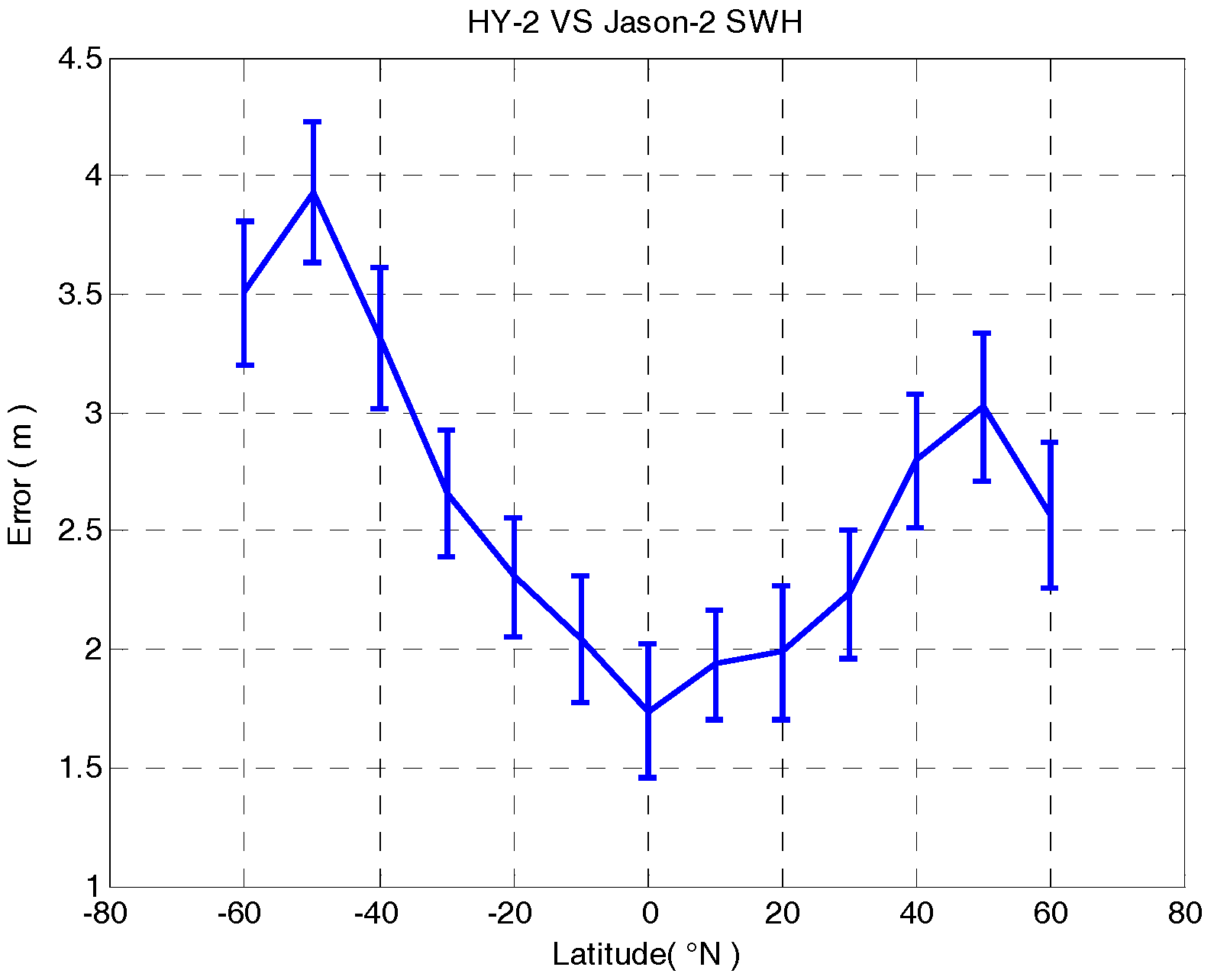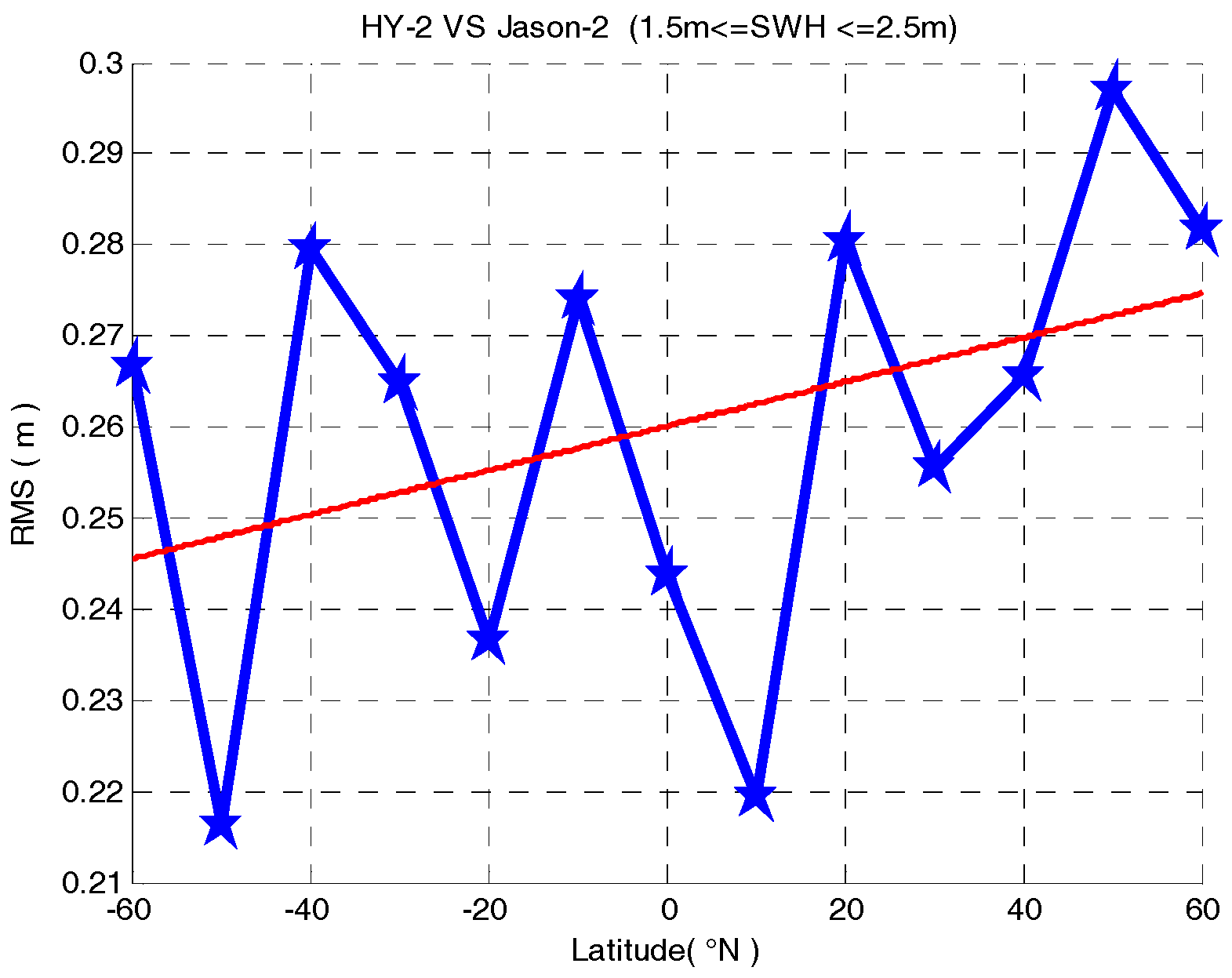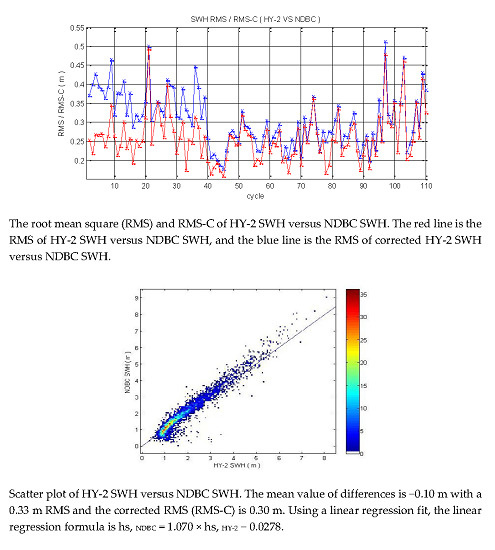1. Introduction
Traditional ocean wave observation is mainly performed via buoys, survey ships, and tide stations, and the coverage is very limited. These methods, however, cannot meet the needs of the current high-speed development of the economy and of scientific research. Altimetry effectively solves this problem, as it can provide large-scale, near-synchronous, high-spatial- and high-temporal-resolution observations. Altimeters have provided continuous wave height measurements for more than 20 years. Moreover, altimeter data have been widely used. The change from experimental ocean satellites to operational ocean satellites was significant [
1]. Satellite altimeter operation benefits from continuously improving measurement accuracy and calibration and validation methods.
With the improvement of accuracy in altimeter observations and data processing methods, the altimeter data have been widely used in various fields, such as ocean circulation, ocean tides, middle scale eddies, upwelling currents, frontal eddies, and geodetic leveling [
2,
3]. Moreover, the application of altimeter SWH measurements to numerical ocean models has grown dramatically. The ERS-2 (since January 1996) and ENVISAT fast delivery altimeter SWH data were assimilated in ECMWF numerical wave models [
4]. The positive impact of the satellite altimeter SWH data assimilation in numerical wave models has been estimated on the coastal scale or global scale [
4,
5,
6]. Altimeter sea surface height anomaly (SSHA) data can be assimilated to the Princeton ocean model (POM), which improved the sea surface dynamic height and the results of the deep current field in the East China Sea [
1]. The merged SWH data from HY-2, Jason-1/2, and ENVISAT can be used to analyze the characteristics of SWH in China’s seas and adjacent waters [
7].
The success of assimilating multi-satellite data at global and regional scales depends upon two main conditions. The first one is the improvement of the accuracy of the altimeter observations and data processing methods. The second one is to determine the accuracy and the errors of the SWH measurements from various altimeters. Calibration and validation plans are usually conducted after operational satellite altimeters are launched. Based on these plans, these sea surface height (SSH), SWH, and backscattering coefficient measurements are calibrated and validated during dedicated commissioning phase operations [
8,
9]. Long-term monitoring of the quality of estimated geophysical parameters is then needed, since electronic drift and sensor degradations can affect the quality of measurements. The results of ENVISAT RA-2 wind and wave validation performed within the ESA RA-2 cross-calibration and validation team (CCVT) activities during the ENVISAT commissioning phase, as well as SWH and wind measurements from ERS-1/2, TOPEX/POSEIDON, and Jason-1/2, the results of long-term validation and proposed corrections, have been presented [
9,
10,
11]. Since HY-2 was launched, there have been several published works evaluating HY-2 SWH accuracy; these works have consistently demonstrated its accuracy [
12,
13,
14,
15,
16]. Some works focused on the preliminary calibration of HY-2 SWH shortly after its launch [
7,
12,
13,
17]. Some works focused on the HY-2 SWH correction method [
15,
16]. A conclusion can be drawn that HY-2 tends to overestimate the low sea state and underestimate wave heights throughout the remaining range of heights, especially for the high sea state [
12,
16]. The overall negative bias is 0.2 m and the RMS is 0.3 m [
15]. All of these studies employed a 50 km spatial and 0.5 h temporal window for collocation, but the error caused by the spatial window was not discussed.
In this study, the HY-2 Ku band SWH data were validated by the SWH data from the NDBC buoy and cross-validated by Jason-2 Ku band SWH data for a long-term period. A linear regression formula was provided to ensure that the SWH data from HY-2A can work with other satellite altimetry data. Moreover, the uncertainty of HY-2 SWH measurements was estimated by coincident NDBC SWH measurements.
Section 2 describes the data matching methods, statistics parameters, and the regression method used.
Section 4 discusses the uncertainty of HY-2 SWH measurements and the error spatial variation. Finally,
Section 5 states conclusions.
2. Materials and Methods
2.1. Materials
HY-2 was launched by China on 16 August 2011. It flies at an altitude of 971 km and an orbital inclination angle of 99.34°, an angle that allows for measurement closer to the poles. Its remote sensing loads include a microwave scatterometer, a radar altimeter, a scanning microwave radiometer, and a three-frequency microwave radiometer. The radar altimeter is used to detect the sea surface height (SSH), the SWH, and the sea surface wind speed (SSW).
In this paper, the HY-2 SWH data are Level 2 IGDR (interim geophysical data record) products distributed by the National Satellite Ocean Application Service (NSOAS), the State Oceanic Administration of China. The IGDR data mainly include the SWH, SSH, SSW, and relevant correction parameters, which were used to calculate the SSH. More than 4 years of HY-2 IGDR data (Cycle 1 to Cycle 110, from 1 October 2011 to 19 December 2015) are used here. During Cycle 40, the HY-2 satellite changes its altimeter sensor from the main one (Alt-A) to the backup one (Alt-B). Then, there are only 65 pass data in Cycle 40 (from Pass 1 to Pass 61) and only 305 pass data in Cycle 41 (from Pass 81 to Pass 386).
In order to validate the HY-2 Ku band SWH data, the Jason-2 data were collected for comparison. Jason-2 took over and continued the TOPEX/Poseidon and Jason-1 missions in 2008, in cooperation with CNES, Eumetsat, NASA, and NOAA. The Jason-2 has an orbit inclination angle of 66.04°, so all comparisons are located from 66.04° N to 66.04° S. In this paper, the Jason-2 SWH data are Level 2 GDR (geophysical data record) products distributed by CNES-AVISO. The Jason-2 altimeter data are collected from Cycle 119 to Cycle 268, a time span that is almost the same as that of the HY-2 data mentioned above. Data from both HY-2 and Jason-2 are used the Ku band SWH measurements.
The buoy data are generally assumed to be of high quality and have been used for validation altimeter SWH data [
7,
10,
12,
13,
14,
15,
16,
17,
18,
19,
20]. The buoy data used here is regarded as “truth”; that is to say, any error is negligible. The buoy SWH data are obtained from the U.S. National Data Buoy Centre (NDBC), provided by NOAA, from October 2011 to 19 December 2015.
2.2. Methods
Using a spatial and temporal window, the collocation data set is established for the altimeter SWH validation. The ocean wave field varies temporally and spatially. Buoy measurements are the temporal variation of the wave field in a fixed buoy location; meanwhile, the altimeter measurements are the spatial variation in the wave field in a synchronous time. So the choice of the spatial and temporal window plays a key role in SWH validation, which can affect the final SWH accuracy.
Collocation criteria of 30 min for the temporal window and 50 km for the spatial window have been widely adopted since 1988 [
19]. The validation of T/P, ENVISAT, Jason-1, and Jason-2 SWH measurements also used this criteria. In this paper, the spatial and temporal window is the same window used to compare the accuracy of the HY-2 altimeter with that of NDBC and Jason-2 in the SWH range of 0.5–11 m. For NDBC comparisons, the collocated data are selected when the distance approach of the altimeter ground track is less than 50 km, within a 0.5 h time window. Altimeter-collocated data are estimated as the distance between the altimeter and buoy is less than 50 km, and the along-track average of the altimeter data. For altimeter cross-comparisons, pairs of satellite data are selected when the time window selected as 0.5 h and 50 km each side of the crossing point, in order to filter time and space variability effects.
Results are presented as scatter plots and in tables, providing the number of data analyzed, the mean bias value, the RMS of HY-2 SWH and other altimeter or buoy SWH, the slope, and the intercept of the linear regression line between HY-2 SWH (x-axis) and other measurements (y-axis). Since the buoy/Jason-2 SWH data is treated as true, regressing the altimeter data onto the buoy data/Jason-2 is a good choice, regarding the HY-2 altimeter data as a dependent variable and the buoy/Jason-2 data as an independent variable. The slope and the intercept can eventually be used to directly correct the HY-2 SWH (the corrected SWH equals slope multiplied by measurement plus intercept).
4. Discussion
Using NDBC data and Jason-2 data, HY-2 IGDR SWH data were validated.
Table 1 provides the statistical results for HY-2 SWH comparisons. As indicated in
Table 1, the RMS was similar in the two comparisons, about 0.3~0.4 m; the two RMSs were similar, and the linear regression formula was also similar. Thus, validations of NDBC and Jason-2 comparisons with HY-2 have good consistency. The RMS of the Jason-1 SWH was 0.35 m when the NDBC SWH was used to validate Jason-1, and the RMS of Jason-2 SWH was 0.37 m at the Ocean Surface Topography Science Team 2008 meeting [
17]. The HY-2 RMS was 0.33 m when validated by NDBC SWH, which is very similar to the accuracy of the Jason-1/2 SWH. Yang et al. used the NDBC to validate the HY-2 SWH data, and the correction formula was hs,
NDBC = 1.0698 × hs,
HY-2 + 0.1397 [
7], which presents a slope similar to that of our ALT-A result: hs,
NDBC = 1.071 × hs,
HY-2 + 0.0700. The overall negative bias of HY-2 SWH has been shown to be about 0.2~0.3 m, and the RMS shown to be about 0.3~0.4 m compared with the NDBC SWH [
12,
13,
14,
15,
16], which is similar to our work (
Table 1).
Queffeulou has done long-term quality status validations with international operational altimeters, showing that the corrected ERS-1 RMS is 0.28 m, that the corrected ERS-2 RMS is 0.27 m, and that the corrected POSEIDON of T/P RMS is 0.25 m when compared with Buoy SWH [
10]. The final report of Cross-Validation of ENVISATRA-2 Significant Wave Height, Sigma0 and Wind Speed shows that the RMS of the corrected ENVISAT RA-2 SWH is 0.32 m, and the RMS of Jason-1 is 0.27 m [
20]. The RMS of corrected HY-2 data compared with NDBC data is 0.30 m (
Table 1 Line 2), which indicates that the accuracy of HY-2 SWH is similar to that of the international operational altimeters, and the linear regression formula is useful in the correction of HY-2 SWH.
By comparing NDBC with Jason-2, it is obvious that the HY-2 SWH is lower than others in whole sea state situations (see
Figure 4 and
Figure 8). The bias of HY-2 SWH clearly jumps during Cycles 40 and 41 (see
Figure 2 and
Figure 6), which was caused by altimeter sensor switching from primary (ALT-A) to backup (ALT-B); the ALT-A and ALT-B have different accuracies and linear regression; the accuracy of ALT-A is lower than ALT-B, as shown in
Table 1, Line 3, and Line 4, almost 0.10 m in RMS; but after the linear regression, the accuracy is almost the same.
4.1. HY-2 SWH Uncertainty Analysis
The uncertainty of HY-2 SWH was estimated by coincident NDBC SWH. The RMS between the HY-2 and the NDBC included the uncertainty in HY-2 measurements (∆HY2), the uncertainty in NDBC measurements (∆NDBC), and the uncertainty due to spatial and temporal decorrelation (∆S,∆T) [
21].
Evidently, ∆S and ∆T will equal to 0 in the ideal case that the data from HY-2 and NDBC are totally coincident. Thus, Equation (1) can be rewritten as
where the term of RMS
(HY2-NDBC) (0, 0) is the RMS when the measurements of HY-2 and NDBC are totally coincident.
In order to make an estimation of ∆HY2, it is necessary to obtain the value of RMS (HY2-NDBC) (0, 0). In this paper, the temporal window was set to less than 0.5 h. The spatial interval effect can be estimated by forming a data set of the SWH uncertainty as a function of different spatial intervals.
The buoy data used here is regarded as “truth”; that is to say, the error of buoy SWH is negligible. Therefore, the RMS (HY2-NDBC) (0, 0) can be treated as the error of HY-2 SWH.
Consequently, using the correction formula (as shown in
Figure 9), the uncertainty of HY-2 SWH can be written as
The accuracy of HY-2 SWH is 0.17 ± 0.04 m, which evaluated the uncertainty after being corrected by NDBC measurements. Twelve synchronal experiments in South China Sea were launched to validate the accuracy of the HY-2 SWH from October to November in 2011. The position of the buoy was exactly at the HY-2 altimeter ground point [
12]. The bias was 0.22 m with an RMS of 0.27 m. Using the linear regression formula hs,
buoy = 1.11 × hs,
HY-2 − 0.413, the RMS of HY-2 SWH was reduced to 0.17 m, which is the same as the uncertainty of the HY-2 SWH evaluated by NDBC.
4.2. The Error Spatial Variation
Using the Jason-2 SWH data, the spatial variation in the HY-2 SWH error was evaluated. In order to reduce the error caused by spatial distance, the distance between HY-2 and Jason-2 was fixed to less than 3.5 km. The error bar figure of whole sea states is shown in
Figure 10.
The range of RMS value (the vertical lines in
Figure 10) is from 0.2 to 0.3 m, with no significant variation in latitude. The average sea state varies with latitude as shown in
Figure 10, and the lower sea state is in the equatorial ocean region.
For analyzing the variation in the error bar with a latitude in the same sea state, the sea state in the middle wave (1.5 m <= SWH <= 2.5 m) was selected. The range of RMS values (the blue line in
Figure 11) is from 0.2 to 0.3 m. In the middle wave sea state, the RMS value increases with the latitude from south to north, as shown in
Figure 11.
5. Conclusions
Using the NDBC data and Jason-2 data, the accuracy of HY-2 SWH measurements was validated. The results show that the HY-2 SWH raw data have an accuracy similar to that of the international operational Jason-1/2 SWH data. Using a linear regression formula, the accuracy of the corrected HY-2 SWH is obviously improved, indicating the feasibility of using a linear regression formula to correct the HY-2 SWH. The value of HY-2 SWH is higher in lower sea state situations and lower in the whole sea situation.
Using error budget analysis, the accuracy of HY-2 SWH is 0.17 ± 0.04 m, which evaluated the uncertainty after being corrected by NDBC measurements. The accuracy of HY-2 SWH has no significant variation with latitude in whole sea states, but in the middle wave sea state, the RMS value of HY-2 SWH is increasing with the latitude from south to north.
